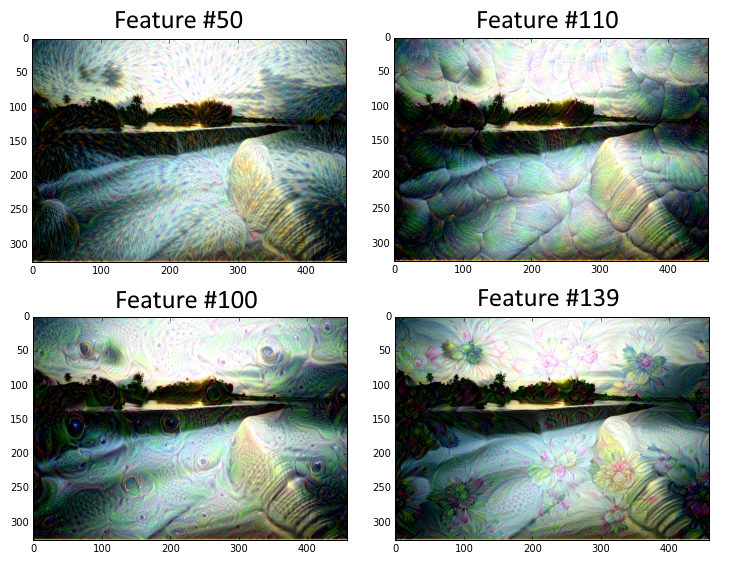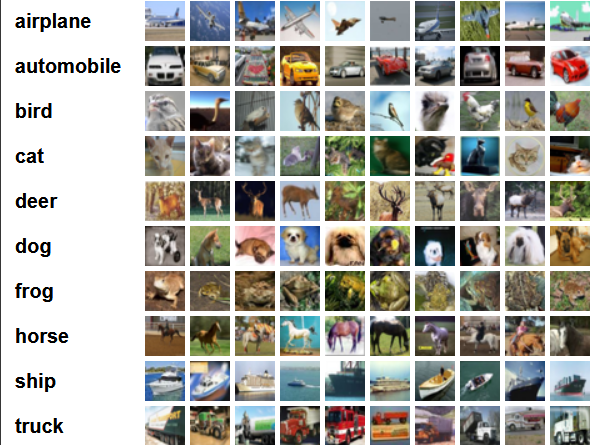0. 滴不尽相思血泪抛红豆
上一节讲述了如何通过CNN提取一幅图像的特征后,并将提取的“滤镜”应用于另外一幅图像。其实利用CNN产生这种艺术作品的应用和论文还有很多,例如google著名的DeepDream,它利用以及训练好的网络(例如一个二分类猫狗的网络),识别任意图片(例如一朵云的图片)后将其判别为猫或者狗,并将猫狗的特征复刻到云朵照片上,使计算机“做梦”一样,看到云朵而联想到猫狗,从而创造了新的艺术作品。利用CIFAR-1000训练好的网络来产生DeepDream效果如下图所示:

可以看到,上图中的一些斑点、花纹、水波都是原图中不曾出现的。而通过CIFAR-1000训练的分类网络,在读取图片时,将图片某些局部信息分类为了水波、花纹、斑点等,再通过局部特征信息提取、融合某个分类的特征,从而创作了上述作品。因为这个内容的实际应用不是很大,所以之后的博客看情况再决定要不要贴出来这一块的内容。
本篇博客要完成的是更基础的内容。通过CIFAR-10训练集,训练CNN网络来进行图像分类。首先认识一下CIFAR-10训练集。
CIFAR-10共有60000张32*32像素的图片,被分为10个类别(是不是有点像MNIST呢,但是难度有上升呢),每一类自然有6000张图片。数据集链接为http://www.cs.toronto.edu/~kriz/cifar.html(170.1MB,无需单独下载啦,为了方便小白猫已经把下载写到代码里了,运行python会自动在代码根目录产生temp文件夹存放数据集)。CIFAR-10的分类示例如下图所示:

1. 看不完春柳春花满画楼
1.1 代码
在之前章节也提到过,CNN网络中的基本步骤是重复conv-relu-pool后,再加上全连接层后通过softmax输出最后分类概率向量,误差函数由softmax loss构成。其中conv-relu-pool的重复是加深CNN网络的基础方法,它能让网络更复杂准确率更高。所以针对CAFIA-10的图像分类代码和之前的MNIST只是在网络深度上有了差别。
使用50k图片进行训练,10k图片进行测试。另外值得注意的是,训练集较大时(本例的50k图片)不能全部放入内存。参考tensorflow的官方文档,需要创建一个图像数据读取器,每次训练喂入一个批量的数据,防止内存溢出。相同的,测试时也一批一批的进行测试,计算平均准确率。
CPU条件下大概要运行1.5-2小时。代码如下:
#---------------------------------------
#
# Author: allen
# Date: 2018.4.20-4.23
import os
import sys
import tarfile
import matplotlib.pyplot as plt
import numpy as np
import tensorflow as tf
from six.moves import urllib
from tensorflow.python.framework import ops
ops.reset_default_graph()
# 目录
abspath = os.path.abspath(__file__)
dname = os.path.dirname(abspath)
os.chdir(dname)
# 开始计算图会话
sess = tf.Session()
# 模型参数
batch_size = 128 # 批量的大小,一次训练和测试的批量大小为128张图片
data_dir = 'temp' # CIFAR-10数据集位置
output_every = 50 # 每训练50次打印一次训练状态
generations = 20000 # 训练20000轮
eval_every = 500 # 每迭代500次,在测试集上进行评估(交叉评估)
image_height = 32
image_width = 32
crop_height = 24
crop_width = 24
num_channels = 3 # 颜色通道(红绿蓝)
num_targets = 10 # 目标分类数
extract_folder = 'cifar-10-batches-bin'
# 初始学习率为0.1,每迭代250次衰减一次学习率。公式为0.1*0.9^(x/250),x为迭代次数
learning_rate = 0.1
lr_decay = 0.1
num_gens_to_wait = 250.
# 读取二进制CIFA-10图片的参数
image_vec_length = image_height * image_width * num_channels
record_length = 1 + image_vec_length # ( + 1 for the 0-9 label)
# 设置下载CIFA-10图像数据集的URL。下载时在代码目录下创建temp文件夹
data_dir = 'temp'
if not os.path.exists(data_dir):
os.makedirs(data_dir)
cifar10_url = 'http://www.cs.toronto.edu/~kriz/cifar-10-binary.tar.gz'
# temp创建,下载cifar-10-binary.tar.gz
data_file = os.path.join(data_dir, 'cifar-10-binary.tar.gz')
if os.path.isfile(data_file):
pass
else:
# 下载.tar.gz压缩包
def progress(block_num, block_size, total_size):
progress_info = [cifar10_url, float(block_num * block_size) / float(total_size) * 100.0]
print(' Downloading {} - {:.2f}%'.format(*progress_info), end="")
filepath, _ = urllib.request.urlretrieve(cifar10_url, data_file, progress)
# 解压
tarfile.open(filepath, 'r:gz').extractall(data_dir)
# 定义图片读取函数,利用tensorflow内置的图像修改函数,返回一个打乱顺序后的数据集
def read_cifar_files(filename_queue, distort_images = True):
reader = tf.FixedLengthRecordReader(record_bytes=record_length)
key, record_string = reader.read(filename_queue)
record_bytes = tf.decode_raw(record_string, tf.uint8)
image_label = tf.cast(tf.slice(record_bytes, [0], [1]), tf.int32)
# 提取图片
image_extracted = tf.reshape(tf.slice(record_bytes, [1], [image_vec_length]),
[num_channels, image_height, image_width])
# 图片同一形状
image_uint8image = tf.transpose(image_extracted, [1, 2, 0])
reshaped_image = tf.cast(image_uint8image, tf.float32)
# 随机打乱图片
final_image = tf.image.resize_image_with_crop_or_pad(reshaped_image, crop_width, crop_height)
if distort_images:
final_image = tf.image.random_flip_left_right(final_image)
final_image = tf.image.random_brightness(final_image,max_delta=63)
final_image = tf.image.random_contrast(final_image,lower=0.2, upper=1.8)
final_image = tf.image.per_image_standardization(final_image)
return(final_image, image_label)
# 声明批处理管道填充函数
def input_pipeline(batch_size, train_logical=True):
if train_logical:
files = [os.path.join(data_dir, extract_folder, 'data_batch_{}.bin'.format(i)) for i in range(1,6)]
else:
files = [os.path.join(data_dir, extract_folder, 'test_batch.bin')]
filename_queue = tf.train.string_input_producer(files)
image, label = read_cifar_files(filename_queue)
# 设置适合的min_after_dequeue很重要。该参数是设置抽样图片缓存最小值。
# tensorflow官方推荐设置为(#threads + error margin)*batch_size。
# 如果设置太大会导致更多的shuffle,从图像队列中shuffle大量的图像数据会消耗更多内存。
min_after_dequeue = 5000
capacity = min_after_dequeue + 3 * batch_size
example_batch, label_batch = tf.train.shuffle_batch([image, label],
batch_size=batch_size,
capacity=capacity,
min_after_dequeue=min_after_dequeue)
return(example_batch, label_batch)
# 声明CNN模型。(重点部分)
# 由两个卷积层(conv-relu-maxpool)加上三个全连接层组成。
def cifar_cnn_model(input_images, batch_size, train_logical=True):
def truncated_normal_var(name, shape, dtype):
return(tf.get_variable(name=name, shape=shape, dtype=dtype, initializer=tf.truncated_normal_initializer(stddev=0.05)))
def zero_var(name, shape, dtype):
return(tf.get_variable(name=name, shape=shape, dtype=dtype, initializer=tf.constant_initializer(0.0)))
# 第一个卷积层(conv-relu-maxpool)
with tf.variable_scope('conv1') as scope:
# 卷积窗口大小为5*5,通道数为3(3种颜色),卷积核个数64(输出特征数)
conv1_kernel = truncated_normal_var(name='conv_kernel1', shape=[5, 5, 3, 64], dtype=tf.float32)
# We convolve across the image with a stride size of 1
conv1 = tf.nn.conv2d(input_images, conv1_kernel, [1, 1, 1, 1], padding='SAME')
# Initialize and add the bias term
conv1_bias = zero_var(name='conv_bias1', shape=[64], dtype=tf.float32)
conv1_add_bias = tf.nn.bias_add(conv1, conv1_bias)
# ReLU element wise
relu_conv1 = tf.nn.relu(conv1_add_bias)
# Max Pooling
pool1 = tf.nn.max_pool(relu_conv1, ksize=[1, 3, 3, 1], strides=[1, 2, 2, 1],padding='SAME', name='pool_layer1')
# Local Response Normalization (parameters from paper)
# paper: http://papers.nips.cc/paper/4824-imagenet-classification-with-deep-convolutional-neural-networks
norm1 = tf.nn.lrn(pool1, depth_radius=5, bias=2.0, alpha=1e-3, beta=0.75, name='norm1')
# 第二个卷积层 同第一个卷积层
with tf.variable_scope('conv2') as scope:
# Conv kernel is 5x5, across all prior 64 features and we create 64 more features
conv2_kernel = truncated_normal_var(name='conv_kernel2', shape=[5, 5, 64, 64], dtype=tf.float32)
# Convolve filter across prior output with stride size of 1
conv2 = tf.nn.conv2d(norm1, conv2_kernel, [1, 1, 1, 1], padding='SAME')
# Initialize and add the bias
conv2_bias = zero_var(name='conv_bias2', shape=[64], dtype=tf.float32)
conv2_add_bias = tf.nn.bias_add(conv2, conv2_bias)
# ReLU element wise
relu_conv2 = tf.nn.relu(conv2_add_bias)
# Max Pooling
pool2 = tf.nn.max_pool(relu_conv2, ksize=[1, 3, 3, 1], strides=[1, 2, 2, 1], padding='SAME', name='pool_layer2')
# Local Response Normalization (parameters from paper)
norm2 = tf.nn.lrn(pool2, depth_radius=5, bias=2.0, alpha=1e-3, beta=0.75, name='norm2')
# Reshape output into a single matrix for multiplication for the fully connected layers
reshaped_output = tf.reshape(norm2, [batch_size, -1])
reshaped_dim = reshaped_output.get_shape()[1].value
# 第一个全连接层
with tf.variable_scope('full1') as scope:
# 第一个全连接层有384个输出
full_weight1 = truncated_normal_var(name='full_mult1', shape=[reshaped_dim, 384], dtype=tf.float32)
full_bias1 = zero_var(name='full_bias1', shape=[384], dtype=tf.float32)
full_layer1 = tf.nn.relu(tf.add(tf.matmul(reshaped_output, full_weight1), full_bias1))
# 第二个全连接层
with tf.variable_scope('full2') as scope:
# 第二个全连接层有192个输出 即384->192
full_weight2 = truncated_normal_var(name='full_mult2', shape=[384, 192], dtype=tf.float32)
full_bias2 = zero_var(name='full_bias2', shape=[192], dtype=tf.float32)
full_layer2 = tf.nn.relu(tf.add(tf.matmul(full_layer1, full_weight2), full_bias2))
# 第三个全连接层 -> 输出10个类别
with tf.variable_scope('full3') as scope:
# 最后一个全连接层有10个输出 即192->10
full_weight3 = truncated_normal_var(name='full_mult3', shape=[192, num_targets], dtype=tf.float32)
full_bias3 = zero_var(name='full_bias3', shape=[num_targets], dtype=tf.float32)
final_output = tf.add(tf.matmul(full_layer2, full_weight3), full_bias3)
return(final_output)
# 损失函数
# 本例使用softmax loss(详见softmax loss节的讲解)
def cifar_loss(logits, targets):
targets = tf.squeeze(tf.cast(targets, tf.int32))
cross_entropy = tf.nn.sparse_softmax_cross_entropy_with_logits(logits=logits, labels=targets)
# 将每个批量测试集准确率均值
cross_entropy_mean = tf.reduce_mean(cross_entropy, name='cross_entropy')
return(cross_entropy_mean)
# 定义训练步骤函数
def train_step(loss_value, generation_num):
# 学习率函数定义(前面已经提到过)
model_learning_rate = tf.train.exponential_decay(learning_rate, generation_num,
num_gens_to_wait, lr_decay, staircase=True)
my_optimizer = tf.train.GradientDescentOptimizer(model_learning_rate)
# 初始化训练步骤
train_step = my_optimizer.minimize(loss_value)
return(train_step)
# 定义准确率函数
# 训练(打乱顺序的)和测试集都可以使用该函数
# 该函数输入logits和目标向量(最后的10个输出),输出平均准确度
def accuracy_of_batch(logits, targets):
targets = tf.squeeze(tf.cast